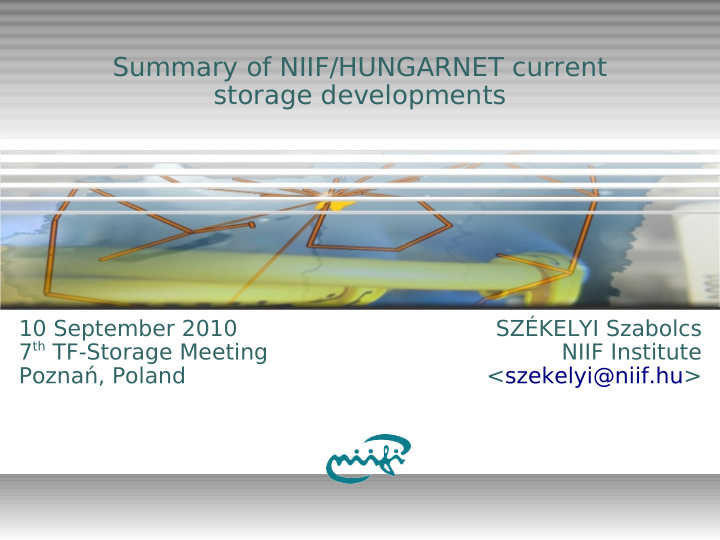



Summary of NIIF/HUNGARNET current storage developments 10 September 2010 SZÉKELYI Szabolcs 7 th TF-Storage Meeting NIIF Institute Poznań, Poland <szekelyi@niif.hu>
Intro Nemzeti Információs Infrastruktúra Fejlesztési Intézet • Who we are Hungarian NREN provider • What we do Providing IPv4 and IPv6 transport services (HBONE) to academic institutions research community public collections, libraries And services on top of it web e-mail videoconferencing VoIP supercomputing grid NIIFI storage development status Page 2
Ongoing projects: HBONE+, TÁMOP Nemzeti Információs Infrastruktúra Fejlesztési Intézet • Established national funding to reengineer the current infrastructure Total financial range: €15M, €5M on distributed computing and data storage • Infrastructure development New 10GbE network • Service development Videoconferencing Trust Federations (AAI) National storage network IaaS cloud • http://www.hboneplus.hu/ NIIFI storage development status Page 3
National storage network Nemzeti Információs Infrastruktúra Fejlesztési Intézet • HBONE-integrated • Installed raw capacity: 500 TB 3 sites Dunaújváros: 240 TB; Sopron: 240 TB; Budapest: 20 TB • Planned total raw capacity: ~1.2 PB • iSCSI based Low-level “block device” service Self-service management • Higher level services World-wide backup (“cloud” backup) Backend storage for IaaS cloud etc. NIIFI storage development status Page 4
Hardware Nemzeti Információs Infrastruktúra Fejlesztési Intézet • Fujitsu-Siemens Eternus DX80 Released June 8, 2009 Specific cost: €400 per TB 4 x 1 GbE ports per storage system 110 MBps per port read-write performance 120 x 1 TB disks per storage system Energy saving Unused disks can turn off automatically Redundant controllers iSCSI interface no need for gateway management through SSH NIIFI storage development status Page 5
Self-service management Nemzeti Információs Infrastruktúra Fejlesztési Intézet • Work in progress, release expected in spring 2011 • Web based • API & GUI • Implemented in Python/Django • Functions: RAID array management Volume management iSCSI target management NIIFI storage development status Page 6
Current possibilities and challenges Nemzeti Információs Infrastruktúra Fejlesztési Intézet • DIY – JBOD & frontend Flexible :-) Lack of human resources :-( Performance and economic penalty :-( More error-prone (?) • Buy more “enterprise-class” storage Lack of features :-( Programmable management interface Multiple (hundreds of) targets per IP address Artificial limitations Number of connected hosts (“up to 64”?!?!), RAID arrays, Volumes, etc. Works out of the box :-) NIIFI storage development status Page 7
IaaS cloud Nemzeti Információs Infrastruktúra Fejlesztési Intézet • Work in progress, beta release in October 2010 • Semi-public Public for our users and member institutions • Each virtual disk is backed by a dedicated iSCSI target Managed automatically using the API just mentioned... • Using KVM as virtualization technology • Using OpenNebula as cloud management system • System-level redundancy • Initial configuration: ~60 nodes, 4 CPU cores and 12 GB RAM each distributed to ~8 sites Debian based, diskless, R/O NFS root • Supercool features, including... NIIFI storage development status Page 8
IaaS cloud features Nemzeti Információs Infrastruktúra Fejlesztési Intézet • 100% realistic virtual networks Self-service management L2 connectivity of virtual machines Secure (L2) separation of virtual networks • Live migration of virtual machines between sites Including virtual disks, networks, etc. Thanks to iSCSI based virtual disks • QoS Guaranteed minimum CPU performance for virtual machines • Virtual machine systems One-click deployment of grids, clusters, etc. NIIFI storage development status Page 9
Thanks for your attention! Questions? SZÉKELYI Szabolcs NIIF Institute <szekelyi@niif.hu>
Recommend
More recommend